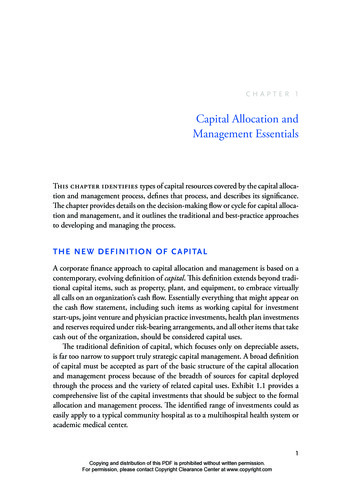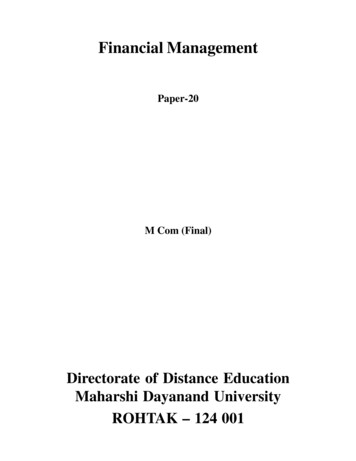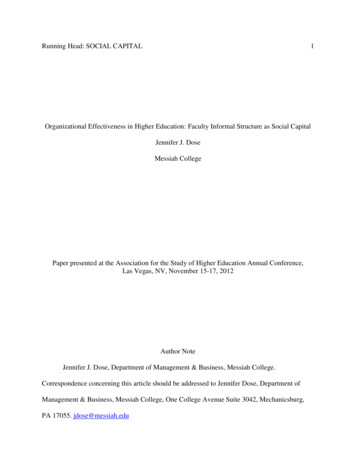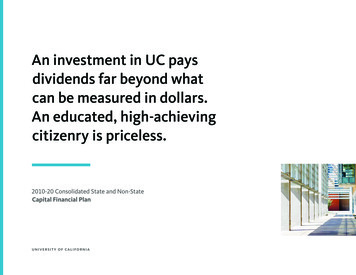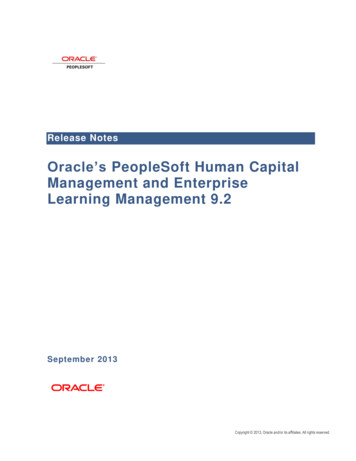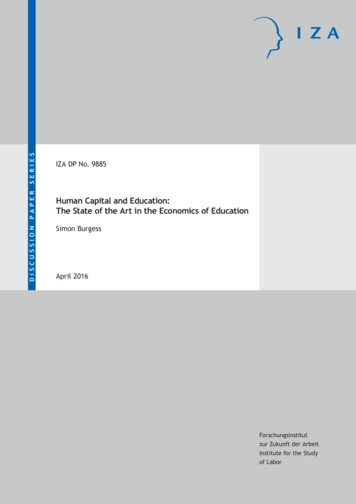
Transcription
SERIESPAPERDISCUSSIONIZA DP No. 9885Human Capital and Education:The State of the Art in the Economics of EducationSimon BurgessApril 2016Forschungsinstitutzur Zukunft der ArbeitInstitute for the Studyof Labor
Human Capital and Education:The State of the Art in theEconomics of EducationSimon BurgessCMPO, University of Bristoland IZADiscussion Paper No. 9885April 2016IZAP.O. Box 724053072 BonnGermanyPhone: 49-228-3894-0Fax: 49-228-3894-180E-mail: iza@iza.orgAny opinions expressed here are those of the author(s) and not those of IZA. Research published inthis series may include views on policy, but the institute itself takes no institutional policy positions.The IZA research network is committed to the IZA Guiding Principles of Research Integrity.The Institute for the Study of Labor (IZA) in Bonn is a local and virtual international research centerand a place of communication between science, politics and business. IZA is an independent nonprofitorganization supported by Deutsche Post Foundation. The center is associated with the University ofBonn and offers a stimulating research environment through its international network, workshops andconferences, data service, project support, research visits and doctoral program. IZA engages in (i)original and internationally competitive research in all fields of labor economics, (ii) development ofpolicy concepts, and (iii) dissemination of research results and concepts to the interested public.IZA Discussion Papers often represent preliminary work and are circulated to encourage discussion.Citation of such a paper should account for its provisional character. A revised version may beavailable directly from the author.
IZA Discussion Paper No. 9885April 2016ABSTRACTHuman Capital and Education:The State of the Art in the Economics of Education*This review describes the research frontier on human capital and education in economicsresearch. It delineates what is known and largely agreed, and what are the most promisinglines for future research. The approach will be to explain clearly and precisely the researchevidence, in a way that makes this accessible to a wide audience. The survey has twoparticular aims. First, it draws out the implications for key education policy issues, highlightingwhich policy ideas can be supported by the economics research. To do this, my focus is onresearch that identifies causal effects. Second, it tries to identify some of the big openresearch questions and policy knowledge gaps in this field.JEL Classification:Keywords:I20education, human capitalCorresponding author:Simon BurgessCentre for Market and Public OrganisationSchool of Economics, Finance and ManagementUniversity of Bristol2C1, The Priory Road ComplexPriory Road, Clifton BS8 1TU, BristolUnited KingdomE-mail: simon.burgess@bristol.ac.uk*This evidence review is produced for COEURE: Cooperation on European Research in Economics.“This is a cooperative action financed by the European Commission within the FP7, a forum whichbrings together the key stakeholders in the European economic research space. Its objective is toformulate an Agenda for Research Funding for Economics in Europe (ARFEE).” For more details, see:http://www.coeure.eu/. I would like to thank a number of people for their comments and suggestions.Most thanks of all to Susanna Loeb, who was particularly helpful and made a number of greatsuggestions to improve the first draft. Many thanks also to Paolo Battaglia, Lex Borghans, GabriellaConti, Neil Davies, Matt Dickson, Emla Fitzsimons, Robin Naylor, Kjell Salvanes, Ismael Sanz, PaoloSestito, Helen Simpson, Eleanor Stringer and Anna Vignoles. I would also like to thank Julia Belau,Marc Ivaldi and Wolfgang Leininger for comments and for organisational support. All errors andomissions are my own.
Executive SummaryEducation is crucially important for many of the policy outcomes that citizens and politicians careabout. At an individual level, your education affects your earnings, your employability, and yourchance of succeeding in life having started in a disadvantaged neighbourhood. It also affects yourhealth, future family structure, intellectual fulfilment and other aspects of a good life. At a nationallevel, a country’s stock of skills matters hugely for its prosperity and growth rate. The distribution ofskills is a big determinant of inequality, and the relationship of a person’s skills to their background iscentral to the degree of social or intergenerational mobility.While many disciplines contribute to our understanding of education, economic analysis can offerkey insights for policy-makers. It has a strongly quantitative approach, and a clear framework forunderstanding the decisions and actions of all the relevant actors. Most importantly, it brings arelentless focus on trying to establish causal links between policy variables and outcomes. Whiledescriptive studies can be invaluable for improving our understanding, policy decisions can only besecurely made on the basis of causal relationships.This paper reviews the current state of the evidence in the economics of education. The aim is toidentify the frontier of knowledge in this field, to present what is largely agreed, and to sketch outwhat the open questions for research are. Additionally, the most promising policy options arehighlighted.The following issues have been covered in detail: Family background, family investment and the formation of human capital;The growth of, and interconnections between, cognitive and non-cognitive skills;Early childhood interventions;Challenges to the basic Mincer model of the demand for education;The role of school resources and particularly class size in changing educational outcomes;Measuring teacher effectiveness and identifying effective teachers;Policies to improve teacher effectiveness including hiring, retaining and performance pay;Policies to improve teacher effectiveness including teacher training and development;School choice, school competition and attainment;Tracking, elite schools and inequality;Neighbourhood schools and access to high-performing schools;School accountability;School autonomy;The rate of return to higher education including heterogeneous returns;Access to university and social mobility;Vocational education, training and adult skills.Other topics have also been covered in less depth.2
A few broad areas have been singled out as the best options for policy. This discussion can only be ata relatively high level of generality as each country of the EU will have its own institutions, laws,traditions and issues.Having noted that, the most promising areas for policy are: Teacher effectiveness is by far the most important thing that matters in school. The difference inoutcomes for pupils taught by effective or ineffective teachers is huge. More research is neededto better define promising policy options, but the two possibilities are to raise averageeffectiveness by selecting better teachers by changing hiring, retention and contract structure;or to raise the average by raising the effectiveness of each teacher through more focussed initialteacher training and by development once in post.Investment in the early years of child development is very important. It is essential that this notbe understood to mean that investment in later years is pointless; that is clearly not the case.Policies to provide more high-quality child care, parenting programmes, and parental leaveprogrammes are crucial, and we are beginning to learn what the best features of such schemesare. Such interventions are typically more important in disadvantaged neighbourhoods.A coherent market structure for schools to operate in is very important. This is a structure withstrong accountability, largely autonomous schools, and centralised tests at the end ofcompulsory schooling. The content of the accountability criteria, the nature of schools’autonomy and the design of the tests are still being researched, but within and across countryevidence shows the importance of having such structures.The review also highlights some questions where more research would be particularly valuable. Thisis, of course, not to say that research in other areas of the economics of education would not also beuseful. These include greater understanding of the formation of human capital, modelling theheterogeneity of returns to education, delineating the circumstances when extra resources doimprove outcomes. There are also a number of topics under the heading of teacher effectiveness.Turning to school markets, further research would be very valuable on school accountability andautonomy, the costs and benefits of tracking, and in particular on the practices of effective schools.Finally, there is so much yet to learn in the economics of universities and even more still onvocational education and training.Almost all of this work is empirical and so requires data. For many years, survey data – such as theLabour Force Survey – has been the mainstay of the economics of education. But in more recentyears, researchers have exploited numerous other types of data to great effect, and indeed many ofthe most important recent breakthroughs have come from non-traditional data types. As discussedin the review, these include the use of birth cohort datasets, administrative or register data,internationally comparative datasets, data generated by field experiments, and psychological,neuroscientific and genetic data. An important role for research funding in this field is surely tosupport the creation, maintenance and use of such datasets throughout the EU.3
ContentsExecutive Summary . 21.Introduction . 6a)Why are human capital and education important? . 7b)What can economics contribute to the study of education? . 8c)Organisation of this review. 82.The aims of education – rates of return, inequality and social mobility . 9a)Overview: skills, inequality and social mobility . 9b)i.ii.iii.iv.The return to education - Challenges to the Mincer model . 10Dealing with the endogeneity of schooling . 11Heterogeneity in returns . 12Life-course heterogeneity and cohort effects . 13Uncertainty and the sequential revelation of information . 13c)The rate of return to going to university . 14d)Access to university and social mobility . 16e)Widening the concept of returns to education . 173.The production of education – children and families; pupils, teachers and schools. . 18a)The Formation of Human Capital . 18i.Multiple skills . 19ii.Modelling the dynamics of human capital formation and parental investment in their children . 20iii. Family background and the development of human capital . 23iv. Early childhood interventions . 24b)School effectiveness – resources, class size, teachers and pupils . 26i.School resources . 26ii.Teachers . 29iii. Pupil effort . 39iv. Peers. 41c)The supply of higher education. 43i.Competition . 43ii.Spill-overs . 44d)Training, vocational skills and adult skills . 454.Education systems – assignment, admissions, accountability, autonomy . 47a)i.ii.iii.iv.v.b)Assignment mechanisms . 47What are parental preferences for schools?. 48Pupil assignment by school choice . 49What is the effect of tracking and selective schools on the distribution of attainment? . 53What are the effects of neighbourhood schooling assignment rules? . 54Assigning by income: private schools and the state sector . 55Accountability, autonomy and regulation . 564
i.ii.iii.5.School Accountability . 56School Autonomy . 59School leadership . 62Data for education research . 64a)Survey Data . 64b)Birth cohort data . 65c)International comparative education data . 65d)Administrative or register data . 66e)Data from field experiments . 66f)Other data . 676.Education Policy and Future Research . 67a)Putting it all together: Attainment, skills, inequality and sorting . 67b)Policy. 69i.Improving teacher effectiveness . 69ii.Ensuring high quality ‘early years’ opportunities . 70iii. Designing the optimal school market structure . 70iv. Resources for schools and class-size . 71v.Classroom IT . 71c)Future research priorities in the economics of education . 71i.Formation of human capital: . 71ii.Demand for education: . 72iii. School resources: . 72iv. Teachers and teaching: . 72v.School assignment mechanisms: . 73vi. School accountability: . 73vii.School autonomy and the practices of effective schools: . 73viii.Universities: . 73ix. Vocational education: . 74x.Data: . 74References . 755
1. IntroductionEducation matters crucially for many of the things that citizens and politicians care about. It isimportant for individual earnings and for national prosperity. At a personal level, it matters forgetting on in life, and at a national level it matters for social mobility. It is a central determinant ofinequality and poverty. Of course, providing education costs a lot: on average in 2011 OECDcountries spent over 6% of their GDP on educational institutions; and it accounted for almost 13% oftotal public spending in the OECD 4.pdf), sogovernments are keen to make it as productive as possible. And schooling takes up a lot of time inyoung lives – if you’re under 20 years old, being at school, thinking about school and doing schoolwork take up a huge fraction of your time awake, on average perhaps around 10,000 hours in schoolover the OECD. And in older lives too, parents of school-age children also spend a lot of time, energyand stress worrying about their child’s education.Unsurprisingly then, there has been a lot of research on education. And there has been a lot ofprogress, a number of things that researchers are now fairly confident about. But there are alsomany open questions, and no doubt new questions yet to be asked, so a great deal of research is stillneeded. One of the corollaries of this is that more and different datasets are needed. Newknowledge has been gained by using traditional surveys, including the difference in earnings thatpeople receive for having higher skills. But increasingly, new data types are being exploited in thisfield and it is often these that are yielding the current big breakthroughs. This is set out below, but itincludes administrative data from school records; field experiment data from randomised controltrials undertaken in schools; and neuroscience and psychological data from specialist questionnairesand scans.I take ‘human capital’ to mean the stock of skills, traits and knowledge that an individual possesses.It is important to be clear that there are multiple valuable skills, and that human capital does not justmean IQ. It is really only relatively recently that researchers have begun to map out the range ofskills that can be considered part of human capital and we cannot yet determine precisely whichtypes of human capital matter most in particular eras and contexts. Like other capital, human capitalgrows through being invested in, and that investment is called education. Not all education is donein schools; families are a very important part of the process. But education in schools is perhaps theprimary lever for policies on human capital.This review will describe the research frontier on human capital and education in economicsresearch. It will delineate what is known and largely agreed, and what are the most promising linesfor future research. The approach will be to explain clearly and precisely the research evidence, in away that makes this accessible to a wide audience. The survey has two particular aims. First, it willdraw out the implications for key education policy issues, highlighting which policy ideas can besupported by the economics research. To do this, my focus will be on research that identifies causaleffects. Second, it will try to identify some of the big open research questions and policy knowledgegaps in this field to inform the future research funding agenda.It is also important to be clear what this survey is not. It is obviously not a personal attempt toupdate all the 45 chapters and 2795 pages of the Handbook of the Economics of Education, in a few6
months, all on my own. It is a summary of the state of the art in some key areas. While it willemphasise policy issues throughout, this is not an attempt to construct a detailed manual for policymakers in education. That would be ambitious for just one country, let alone all countries in the EUwith their widely disparate educational institutional structures, legacies and issues. However, theaim is certainly to highlight general areas of potentially fruitful policy, and areas which seem lessuseful. The idea is to make this as free as possible of national institutional detail and to stick togeneral principles.In selecting some areas to focus on, I have had to leave others out. No doubt other researcherswould have made different choices, but I believe that most of the issues I have focussed on here areconsensual. The three topics I have devoted most space to are teachers; the ‘early years’ of humancapital development, and the market structure for schooling. Topics that I have omitted includecurriculum content, compulsory schooling ages, gender and race differences, the overall supply ofteachers, the degree of centralisation of school funding, and over-education. These are far fromunimportant as research topics or as policy issues.Education policy-making in the European Union happens on different levels. Policy is determined ata national level (and see /index.php/Countriesfor levels of devolution), but the European Commission offers support to its members addressingcommon educational challenges, primarily focussing on skills deficits. The relevant framework is“Education and training 2020” (ET2020; ework/index en.htm). ET2020 has four common EU objectives: enhancing lifelong learning;improving the quality and efficiency of education; promoting equity and social cohesion; andenhancing creativity, innovation and entrepreneurship. In 2015, the EU set new priorities foreducation again around promoting employability and skills, increasing social mobility, and also thistime aiming to counteract “fanaticism” and promote democracy.a) Why are human capital and education important?There are three large policy domains for which education is critical. First, a country’s stock of skills iscentral to the potential for economic growth in a highly competitive international environment.Second, the distribution of that human capital is a key determinant of income inequality, ever moreimportant with a high wage premium for skills. Third, the link between a person’s human capital andtheir background is a fundamental determinant of social mobility and the perpetuation ofdisadvantage. These are discussed in detail in section 2a below.A child’s family matters a great deal in understanding the formation of human capital, and this isdiscussed in detail. Beyond that, the provision of education is the main channel through which publicpolicy can affect human capital and skills. The effectiveness of an education system influences theskills that all citizens acquire. The structure of the system affects the distribution of skills; forexample, whether the system increases or decreases the inequality of educational outcomes. Thesystem has to work well in a world of (very) imperfect information, with substantial variation inattributes and across children, allowing for a diversity of outcomes, whilst also respecting othergoals such as children’s wellbeing and rights, parents’ rights, and democratic processes.7
b) What can economics contribute to the study of education?The decisions by families and individuals on how much to invest in human capital are the standardtypes of decisions that economics can fruitfully analyse. They involve trade-offs between currentcosts and future benefits, inter-related dynamic decisions and risk. The education system, whether itis set up like a market or not, nevertheless has actors who have goals and constraints and whointeract in some form or other of allocative mechanism. This is well-suited to an economic analysis.Researchers are using the tools of industrial economics to understand the incentives and constraintsof all the different players in the market, and to analyse their interactions. Typically in Europe andthe US, education does not function as a straightforward marketplace, so there has been interest inother forms of accountability to replace pure market discipline.Another key contribution of economics is a strong quantitative approach. The majority of research inthe economics of education is empirical, and uses a range of techniques including computiblegeneral equilibrium models and programme evaluation (see Meghir and Rivkin, 2011, for a review ofmethods in the field). However, perhaps the most important feature is an emphasis on trying toestimate causal relationships. Causality is not everything and descriptive studies can be extremelyuseful, for example in identifying need for action, but a policy discussion can really only take off fromcausal studies.Of course, other disciplines bring insights to education also. In recent years, economists have startedto combine effectively with psychologists and neuroscientists in the study of the development ofcognitive and non-cognitive abilities and traits (for example, Cunha et al, 2006), with geneticists instudying the origins of traits and abilities (Benjamin et al, 2012) and also with behavioural scientistsin trying to understand motivations and the best way to design incentives (for example Levitt et al,2012).c) Organisation of this reviewThe main part of the survey is organised around three concepts. First are the goals of education,principally covering research on the rate of return to schooling and what follows from that such asinequality and social mobility; wider returns to schooling are also considered. Second, research onthe production of skills, the formation of human capital, both through family investments and alsothrough schooling. Whilst we have learnt a huge amount from recent research here, there remainlarge areas of uncertainty. Third, given the returns and the production function, I discuss the designof education systems, including assignment, accountability and autonomy. In each of these sections– returns, production, systems – I include post-compulsory as well as compulsory schooling. Finally, Iconclude by gathering together the most promising policy ideas and identifying the areas whereresearch funding could most fruitfully be aimed.8
2. The aims of education – rates of return, inequality and socialmobilitya) Overview: skills, inequality and social mobilityEducation is central to three very important policy domains. First, human capital and education arekey, causal, drivers of growth and prosperity. Second, the distribution of human capital acrosspeople is an important determinant of income inequality, ever more important with a high wagepremium for skil
The State of the Art in the Economics of Education Simon Burgess CMPO, University of Bristol and IZA Discussion Paper No. 9885 April 2016 IZA P.O. Box 7240 53072 Bonn Germany Phone: 49-228-3894- Fax: 49-228-3894-180 E-mail: iza@iza.org Any opinions expressed here are those of the author(s) and not those of IZA. Research published in




